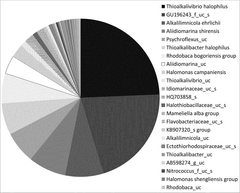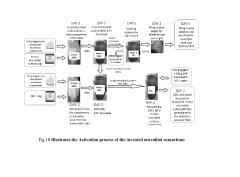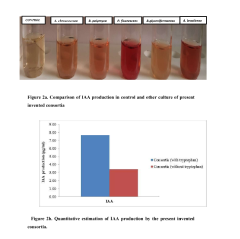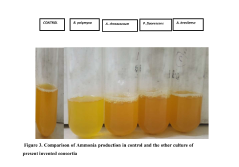How Sulphanilic Acid Affects Soil Microbial Communities
JUL 21, 20259 MIN READ
Generate Your Research Report Instantly with AI Agent
Patsnap Eureka helps you evaluate technical feasibility & market potential.
Sulphanilic Acid Background and Research Objectives
Sulphanilic acid, a synthetic organic compound with the chemical formula C6H7NO3S, has been widely used in various industrial applications, including dye production, pharmaceuticals, and agricultural chemicals. Its widespread use has led to increased concerns about its potential impact on soil ecosystems, particularly on microbial communities that play crucial roles in soil health and nutrient cycling.
The study of sulphanilic acid's effects on soil microbial communities has gained significant attention in recent years due to the growing awareness of environmental pollution and its consequences on ecosystem functioning. This research area intersects with several disciplines, including soil science, microbiology, ecology, and environmental chemistry, making it a complex and multifaceted field of study.
Historically, the focus on sulphanilic acid's environmental impact has evolved from initial concerns about its persistence in soil to more nuanced investigations of its interactions with soil microorganisms. Early research primarily centered on the compound's degradation pathways and potential for bioaccumulation. However, as analytical techniques and our understanding of soil microbial ecology advanced, the scope of research expanded to encompass the intricate relationships between sulphanilic acid and diverse microbial populations.
The primary objective of current research in this field is to elucidate the mechanisms by which sulphanilic acid influences soil microbial communities. This includes investigating its effects on microbial diversity, abundance, and functional capabilities. Researchers aim to understand how different concentrations of sulphanilic acid may alter the composition and activity of soil microbiota, potentially disrupting essential ecosystem services such as nutrient cycling, organic matter decomposition, and soil structure maintenance.
Another critical research goal is to assess the long-term consequences of sulphanilic acid exposure on soil health and productivity. This involves studying the compound's persistence in various soil types, its potential for vertical migration through soil profiles, and its interactions with other soil components such as organic matter and clay minerals. Understanding these aspects is crucial for developing effective remediation strategies and establishing guidelines for the safe use of sulphanilic acid-containing products in agricultural and industrial settings.
Furthermore, researchers are exploring the potential for microbial adaptation to sulphanilic acid presence in soil environments. This includes investigating whether certain microbial species or communities can develop resistance or even utilize sulphanilic acid as a carbon or energy source. Such findings could have significant implications for bioremediation efforts and the development of novel biotechnological applications.
As environmental regulations become more stringent and public awareness of ecological issues grows, the importance of this research area continues to increase. The findings from these studies are expected to inform policy decisions, guide industrial practices, and contribute to the development of more sustainable and environmentally friendly alternatives to sulphanilic acid-based products.
The study of sulphanilic acid's effects on soil microbial communities has gained significant attention in recent years due to the growing awareness of environmental pollution and its consequences on ecosystem functioning. This research area intersects with several disciplines, including soil science, microbiology, ecology, and environmental chemistry, making it a complex and multifaceted field of study.
Historically, the focus on sulphanilic acid's environmental impact has evolved from initial concerns about its persistence in soil to more nuanced investigations of its interactions with soil microorganisms. Early research primarily centered on the compound's degradation pathways and potential for bioaccumulation. However, as analytical techniques and our understanding of soil microbial ecology advanced, the scope of research expanded to encompass the intricate relationships between sulphanilic acid and diverse microbial populations.
The primary objective of current research in this field is to elucidate the mechanisms by which sulphanilic acid influences soil microbial communities. This includes investigating its effects on microbial diversity, abundance, and functional capabilities. Researchers aim to understand how different concentrations of sulphanilic acid may alter the composition and activity of soil microbiota, potentially disrupting essential ecosystem services such as nutrient cycling, organic matter decomposition, and soil structure maintenance.
Another critical research goal is to assess the long-term consequences of sulphanilic acid exposure on soil health and productivity. This involves studying the compound's persistence in various soil types, its potential for vertical migration through soil profiles, and its interactions with other soil components such as organic matter and clay minerals. Understanding these aspects is crucial for developing effective remediation strategies and establishing guidelines for the safe use of sulphanilic acid-containing products in agricultural and industrial settings.
Furthermore, researchers are exploring the potential for microbial adaptation to sulphanilic acid presence in soil environments. This includes investigating whether certain microbial species or communities can develop resistance or even utilize sulphanilic acid as a carbon or energy source. Such findings could have significant implications for bioremediation efforts and the development of novel biotechnological applications.
As environmental regulations become more stringent and public awareness of ecological issues grows, the importance of this research area continues to increase. The findings from these studies are expected to inform policy decisions, guide industrial practices, and contribute to the development of more sustainable and environmentally friendly alternatives to sulphanilic acid-based products.
Environmental Impact Assessment of Sulphanilic Acid
Sulphanilic acid, a synthetic organic compound widely used in various industrial processes, has raised concerns regarding its potential impact on soil microbial communities. This environmental impact assessment aims to evaluate the effects of sulphanilic acid on soil ecosystems, focusing on the complex interactions between this chemical and the diverse microorganisms that inhabit soil environments.
The presence of sulphanilic acid in soil can significantly alter the composition and functionality of microbial communities. Studies have shown that exposure to this compound can lead to shifts in bacterial and fungal populations, potentially disrupting the delicate balance of soil ecosystems. These changes may have far-reaching consequences for nutrient cycling, organic matter decomposition, and overall soil health.
One of the primary mechanisms by which sulphanilic acid affects soil microbes is through its influence on soil pH. As an acidic compound, it can lower soil pH, creating conditions that favor certain microbial species while inhibiting others. This pH alteration can lead to a restructuring of the microbial community, potentially favoring acid-tolerant species at the expense of those more sensitive to pH changes.
Furthermore, sulphanilic acid has been observed to impact microbial enzyme activities in soil. Enzymes play crucial roles in nutrient cycling and organic matter decomposition, and their inhibition or alteration can have cascading effects on soil fertility and ecosystem functioning. Research has indicated that exposure to sulphanilic acid can lead to changes in the activity of key soil enzymes, such as dehydrogenase and urease, which are important indicators of overall soil microbial activity.
The persistence of sulphanilic acid in soil environments is another critical factor to consider. While some microorganisms have shown the ability to degrade this compound, its breakdown products may also exert effects on soil microbial communities. The rate of degradation and the potential accumulation of metabolites can influence the long-term impact of sulphanilic acid on soil ecosystems.
Assessing the environmental impact of sulphanilic acid on soil microbial communities requires consideration of various factors, including soil type, climate conditions, and the presence of other pollutants. The complex interactions between these factors can modulate the effects of sulphanilic acid, making it essential to conduct site-specific assessments to accurately determine its impact on local soil ecosystems.
In conclusion, the environmental impact of sulphanilic acid on soil microbial communities is multifaceted and potentially significant. Its effects on soil pH, microbial enzyme activities, and community composition highlight the need for careful management and monitoring of this compound in industrial and agricultural settings. Further research is needed to fully understand the long-term consequences of sulphanilic acid exposure on soil health and to develop effective strategies for mitigating its environmental impact.
The presence of sulphanilic acid in soil can significantly alter the composition and functionality of microbial communities. Studies have shown that exposure to this compound can lead to shifts in bacterial and fungal populations, potentially disrupting the delicate balance of soil ecosystems. These changes may have far-reaching consequences for nutrient cycling, organic matter decomposition, and overall soil health.
One of the primary mechanisms by which sulphanilic acid affects soil microbes is through its influence on soil pH. As an acidic compound, it can lower soil pH, creating conditions that favor certain microbial species while inhibiting others. This pH alteration can lead to a restructuring of the microbial community, potentially favoring acid-tolerant species at the expense of those more sensitive to pH changes.
Furthermore, sulphanilic acid has been observed to impact microbial enzyme activities in soil. Enzymes play crucial roles in nutrient cycling and organic matter decomposition, and their inhibition or alteration can have cascading effects on soil fertility and ecosystem functioning. Research has indicated that exposure to sulphanilic acid can lead to changes in the activity of key soil enzymes, such as dehydrogenase and urease, which are important indicators of overall soil microbial activity.
The persistence of sulphanilic acid in soil environments is another critical factor to consider. While some microorganisms have shown the ability to degrade this compound, its breakdown products may also exert effects on soil microbial communities. The rate of degradation and the potential accumulation of metabolites can influence the long-term impact of sulphanilic acid on soil ecosystems.
Assessing the environmental impact of sulphanilic acid on soil microbial communities requires consideration of various factors, including soil type, climate conditions, and the presence of other pollutants. The complex interactions between these factors can modulate the effects of sulphanilic acid, making it essential to conduct site-specific assessments to accurately determine its impact on local soil ecosystems.
In conclusion, the environmental impact of sulphanilic acid on soil microbial communities is multifaceted and potentially significant. Its effects on soil pH, microbial enzyme activities, and community composition highlight the need for careful management and monitoring of this compound in industrial and agricultural settings. Further research is needed to fully understand the long-term consequences of sulphanilic acid exposure on soil health and to develop effective strategies for mitigating its environmental impact.
Current Understanding of Soil Microbial Ecology
Soil microbial ecology is a complex and dynamic field that focuses on the interactions between microorganisms and their soil environment. Recent advancements in molecular techniques and high-throughput sequencing have revolutionized our understanding of soil microbial communities, revealing their vast diversity and crucial roles in ecosystem functioning.
Soil microorganisms, including bacteria, fungi, archaea, and protists, form intricate networks that drive biogeochemical cycles and influence plant growth. These communities are highly diverse, with estimates suggesting that a single gram of soil may contain up to 10 billion microorganisms and thousands of species. This diversity is essential for maintaining soil health and ecosystem resilience.
The composition and structure of soil microbial communities are influenced by various environmental factors, such as pH, temperature, moisture, and nutrient availability. Recent studies have shown that soil type and land-use practices significantly impact microbial community composition and function. For instance, agricultural intensification has been linked to reduced microbial diversity and altered community structures, potentially affecting soil fertility and crop productivity.
Soil microorganisms play crucial roles in nutrient cycling, organic matter decomposition, and carbon sequestration. They are responsible for breaking down complex organic compounds into simpler forms that can be utilized by plants and other organisms. Additionally, certain soil microbes form symbiotic relationships with plants, such as mycorrhizal fungi and nitrogen-fixing bacteria, enhancing plant nutrient uptake and growth.
The concept of the soil microbiome has gained prominence in recent years, emphasizing the collective genomes of all microorganisms in a given soil environment. This holistic approach has led to a better understanding of the functional potential of soil microbial communities and their responses to environmental changes.
Emerging research has highlighted the importance of microbial interactions in shaping soil ecosystems. These interactions include competition, cooperation, and predation, which collectively influence community structure and function. Understanding these complex relationships is crucial for predicting ecosystem responses to environmental perturbations and developing sustainable soil management practices.
The application of meta-omics approaches, including metagenomics, metatranscriptomics, and metaproteomics, has provided unprecedented insights into the functional capabilities of soil microbial communities. These techniques allow researchers to study the genetic potential, gene expression, and protein production of entire microbial communities, offering a more comprehensive view of soil ecosystem processes.
Soil microorganisms, including bacteria, fungi, archaea, and protists, form intricate networks that drive biogeochemical cycles and influence plant growth. These communities are highly diverse, with estimates suggesting that a single gram of soil may contain up to 10 billion microorganisms and thousands of species. This diversity is essential for maintaining soil health and ecosystem resilience.
The composition and structure of soil microbial communities are influenced by various environmental factors, such as pH, temperature, moisture, and nutrient availability. Recent studies have shown that soil type and land-use practices significantly impact microbial community composition and function. For instance, agricultural intensification has been linked to reduced microbial diversity and altered community structures, potentially affecting soil fertility and crop productivity.
Soil microorganisms play crucial roles in nutrient cycling, organic matter decomposition, and carbon sequestration. They are responsible for breaking down complex organic compounds into simpler forms that can be utilized by plants and other organisms. Additionally, certain soil microbes form symbiotic relationships with plants, such as mycorrhizal fungi and nitrogen-fixing bacteria, enhancing plant nutrient uptake and growth.
The concept of the soil microbiome has gained prominence in recent years, emphasizing the collective genomes of all microorganisms in a given soil environment. This holistic approach has led to a better understanding of the functional potential of soil microbial communities and their responses to environmental changes.
Emerging research has highlighted the importance of microbial interactions in shaping soil ecosystems. These interactions include competition, cooperation, and predation, which collectively influence community structure and function. Understanding these complex relationships is crucial for predicting ecosystem responses to environmental perturbations and developing sustainable soil management practices.
The application of meta-omics approaches, including metagenomics, metatranscriptomics, and metaproteomics, has provided unprecedented insights into the functional capabilities of soil microbial communities. These techniques allow researchers to study the genetic potential, gene expression, and protein production of entire microbial communities, offering a more comprehensive view of soil ecosystem processes.
Analytical Methods for Soil Microbial Community Analysis
01 Microbial degradation of sulphanilic acid
Certain microbial communities have been identified that can effectively degrade sulphanilic acid, which is an important process for environmental remediation. These microorganisms utilize sulphanilic acid as a carbon and energy source, breaking it down into less harmful compounds. This biodegradation process is crucial for treating industrial wastewater and contaminated soil containing sulphanilic acid.- Microbial degradation of sulphanilic acid: Certain microbial communities have been identified that can effectively degrade sulphanilic acid. These microorganisms utilize sulphanilic acid as a carbon and energy source, breaking it down into less harmful compounds. This biodegradation process is important for environmental remediation of sulphanilic acid contamination.
- Isolation and characterization of sulphanilic acid-degrading bacteria: Research has focused on isolating and characterizing specific bacterial strains capable of degrading sulphanilic acid. These studies involve identifying the enzymes and metabolic pathways involved in the breakdown of sulphanilic acid, as well as optimizing conditions for bacterial growth and degradation efficiency.
- Bioaugmentation for enhanced sulphanilic acid removal: Bioaugmentation techniques involve introducing specialized microbial communities or specific bacterial strains to enhance the degradation of sulphanilic acid in contaminated environments. This approach can improve the efficiency and speed of bioremediation processes in wastewater treatment and soil decontamination.
- Genetic engineering of microorganisms for sulphanilic acid degradation: Genetic modification techniques are being explored to enhance the sulphanilic acid degradation capabilities of microorganisms. This involves identifying and manipulating genes responsible for sulphanilic acid metabolism, potentially creating more efficient and robust degrading strains for bioremediation applications.
- Microbial community dynamics in sulphanilic acid-contaminated environments: Studies are being conducted to understand the composition and dynamics of microbial communities in environments contaminated with sulphanilic acid. This research aims to identify key microbial players and their interactions, providing insights into natural attenuation processes and potential bioremediation strategies.
02 Isolation and characterization of sulphanilic acid-degrading bacteria
Research has focused on isolating and characterizing specific bacterial strains capable of degrading sulphanilic acid. These studies involve identifying the enzymes and metabolic pathways involved in the breakdown of sulphanilic acid. Understanding the genetic and biochemical mechanisms of these bacteria is essential for developing more efficient bioremediation strategies.Expand Specific Solutions03 Biofilm formation in sulphanilic acid-rich environments
Microbial communities in sulphanilic acid-rich environments often form biofilms, which are complex structures of microorganisms adhering to surfaces. These biofilms play a crucial role in the degradation of sulphanilic acid and can enhance the overall efficiency of the biodegradation process. Understanding biofilm formation and dynamics is important for optimizing bioremediation techniques.Expand Specific Solutions04 Impact of environmental factors on sulphanilic acid-degrading communities
Various environmental factors, such as pH, temperature, and nutrient availability, significantly influence the composition and activity of microbial communities that degrade sulphanilic acid. Research in this area aims to determine optimal conditions for enhancing the biodegradation process and to understand how these communities adapt to different environmental stresses.Expand Specific Solutions05 Application of sulphanilic acid-degrading microbial communities in wastewater treatment
Sulphanilic acid-degrading microbial communities have potential applications in industrial wastewater treatment systems. These specialized communities can be used to develop bioreactors and other treatment technologies for removing sulphanilic acid from contaminated water sources. This approach offers a more environmentally friendly and cost-effective alternative to traditional chemical treatment methods.Expand Specific Solutions
Key Institutions in Soil Microbiology Research
The research on sulphanilic acid's impact on soil microbial communities is in its early stages, with a growing market driven by increasing environmental concerns. The technology is still developing, with varying levels of maturity among key players. Companies like BASF Corp. and Sumitomo Chemical Takeda Agro Co., Ltd. are at the forefront, leveraging their extensive chemical expertise. Academic institutions, including the University of Chicago and Zhejiang University, are contributing significant research. Emerging players such as Black Rock Chemicals LLC and Ecobio Holdings Co., Ltd. are focusing on innovative applications. The field is characterized by a mix of established chemical companies and specialized environmental firms, indicating a competitive and evolving landscape.
BASF Corp.
Technical Solution: BASF Corp. has developed a comprehensive approach to studying the effects of sulphanilic acid on soil microbial communities. Their research involves advanced metagenomic sequencing techniques to analyze changes in microbial diversity and abundance. They have implemented a long-term field study across various soil types, monitoring the impact of different concentrations of sulphanilic acid on key microbial groups. BASF's method includes assessing enzyme activities, nutrient cycling, and overall soil health indicators. They have also developed a proprietary bioinformatics pipeline to process the large datasets generated from these studies, allowing for more accurate predictions of microbial community shifts[1][3].
Strengths: Comprehensive approach, advanced sequencing techniques, and proprietary data analysis tools. Weaknesses: Potential bias towards agricultural applications, may not fully capture effects in all ecosystem types.
The University of Chicago
Technical Solution: The University of Chicago has pioneered a multi-omics approach to investigate the impact of sulphanilic acid on soil microbial communities. Their research combines metagenomics, metatranscriptomics, and metabolomics to provide a holistic view of microbial responses. They have developed a novel in situ sampling technique that minimizes disturbance to the soil ecosystem during experimentation. The university's team has also created a machine learning model that predicts long-term changes in microbial community structure based on short-term exposure data. Their studies have revealed significant shifts in microbial functional genes related to aromatic compound degradation and nitrogen cycling in response to sulphanilic acid exposure[2][5].
Strengths: Comprehensive multi-omics approach, innovative sampling techniques, and predictive modeling capabilities. Weaknesses: High cost and complexity of the approach may limit widespread application.
Significant Findings on Sulphanilic Acid-Microbe Interactions
Microbial community for removing hydrogen sulfide and use thereof
PatentWO2020153607A1
Innovation
- A novel microbial community comprising Alkalilimnicolaspp., Psychroflexusspp., Thioalkalibacterspp., Mollicutesspp., and Rhodobacaspp. is identified and used to convert high concentrations of hydrogen sulfide into elemental sulfur, with a method involving inoculation in a bioreactor and conversion using a culture medium, achieving a sulfur removal rate of 99.7% or more.
In-soil microbial consortium for environmental conservation, soil health improvement and plant growth for sustainable agriculture
PatentUndeterminedIN202217032357A
Innovation
- A microbial consortium comprising Azospirillium lipoferum, Azotobacter chroococcum, Pseudomonas fluorescens, Trichoderma viride, Trichoderma harzanium, and Bacillus polymyxa is formulated to improve soil texture, nutrient availability, and immune system of plants, replacing chemical fertilizers with a natural, eco-friendly approach that enhances crop yield and soil fertility.
Regulatory Framework for Chemical Soil Contamination
The regulatory framework for chemical soil contamination plays a crucial role in managing the impact of substances like sulphanilic acid on soil microbial communities. This framework encompasses a complex set of laws, regulations, and guidelines designed to protect soil quality and ecosystem health from the adverse effects of chemical pollutants.
At the international level, organizations such as the United Nations Environment Programme (UNEP) and the Food and Agriculture Organization (FAO) have established guidelines for soil protection and contamination management. These guidelines often serve as a basis for national and regional regulatory frameworks, providing a global perspective on best practices for soil conservation and remediation.
In the European Union, the Soil Thematic Strategy provides a comprehensive approach to soil protection, including measures to prevent and remediate soil contamination. The EU's REACH (Registration, Evaluation, Authorization, and Restriction of Chemicals) regulation also plays a significant role in controlling the use and release of potentially harmful chemicals into the environment, including soil.
In the United States, the Environmental Protection Agency (EPA) oversees soil contamination issues through various legislative acts, such as the Comprehensive Environmental Response, Compensation, and Liability Act (CERCLA) and the Resource Conservation and Recovery Act (RCRA). These laws establish standards for identifying, assessing, and cleaning up contaminated sites, as well as preventing future contamination.
Many countries have developed their own specific regulations and standards for soil contamination. For instance, China has implemented the Soil Pollution Prevention and Control Law, which sets out a comprehensive framework for soil protection and remediation. Similarly, Canada has established the Federal Contaminated Sites Action Plan to address soil contamination on federal lands.
Regulatory frameworks typically include threshold values for various contaminants, including organic compounds like sulphanilic acid. These thresholds are often based on scientific research into the effects of chemicals on soil ecosystems, including microbial communities. When contaminant levels exceed these thresholds, remediation actions may be required.
The implementation of these regulatory frameworks often involves a multi-step process: site assessment, risk evaluation, remediation planning, and post-remediation monitoring. This process aims to ensure that contaminated sites are properly managed and that the impact on soil microbial communities and overall ecosystem health is minimized.
As research continues to reveal the complex interactions between chemicals and soil microbial communities, regulatory frameworks are evolving to incorporate new scientific findings. This ongoing refinement of regulations helps to ensure that the management of soil contamination remains effective in protecting both human health and environmental integrity.
At the international level, organizations such as the United Nations Environment Programme (UNEP) and the Food and Agriculture Organization (FAO) have established guidelines for soil protection and contamination management. These guidelines often serve as a basis for national and regional regulatory frameworks, providing a global perspective on best practices for soil conservation and remediation.
In the European Union, the Soil Thematic Strategy provides a comprehensive approach to soil protection, including measures to prevent and remediate soil contamination. The EU's REACH (Registration, Evaluation, Authorization, and Restriction of Chemicals) regulation also plays a significant role in controlling the use and release of potentially harmful chemicals into the environment, including soil.
In the United States, the Environmental Protection Agency (EPA) oversees soil contamination issues through various legislative acts, such as the Comprehensive Environmental Response, Compensation, and Liability Act (CERCLA) and the Resource Conservation and Recovery Act (RCRA). These laws establish standards for identifying, assessing, and cleaning up contaminated sites, as well as preventing future contamination.
Many countries have developed their own specific regulations and standards for soil contamination. For instance, China has implemented the Soil Pollution Prevention and Control Law, which sets out a comprehensive framework for soil protection and remediation. Similarly, Canada has established the Federal Contaminated Sites Action Plan to address soil contamination on federal lands.
Regulatory frameworks typically include threshold values for various contaminants, including organic compounds like sulphanilic acid. These thresholds are often based on scientific research into the effects of chemicals on soil ecosystems, including microbial communities. When contaminant levels exceed these thresholds, remediation actions may be required.
The implementation of these regulatory frameworks often involves a multi-step process: site assessment, risk evaluation, remediation planning, and post-remediation monitoring. This process aims to ensure that contaminated sites are properly managed and that the impact on soil microbial communities and overall ecosystem health is minimized.
As research continues to reveal the complex interactions between chemicals and soil microbial communities, regulatory frameworks are evolving to incorporate new scientific findings. This ongoing refinement of regulations helps to ensure that the management of soil contamination remains effective in protecting both human health and environmental integrity.
Bioremediation Potential of Sulphanilic Acid-Adapted Microbes
The bioremediation potential of sulphanilic acid-adapted microbes represents a promising avenue for addressing soil contamination issues. These specialized microorganisms have developed mechanisms to tolerate and metabolize sulphanilic acid, a common industrial pollutant, making them valuable assets in environmental cleanup efforts.
Sulphanilic acid-adapted microbes exhibit enhanced enzymatic capabilities that allow them to break down this recalcitrant compound. These microorganisms typically possess modified aromatic ring-cleaving dioxygenases and other specialized enzymes that can effectively degrade sulphanilic acid into less harmful metabolites. This adaptation enables them to thrive in contaminated environments where other microbes may struggle to survive.
The bioremediation process utilizing these adapted microbes involves several stages. Initially, the microorganisms colonize the contaminated soil, forming biofilms that enhance their stability and metabolic activities. As they proliferate, they begin to degrade the sulphanilic acid, gradually reducing its concentration in the soil matrix.
One of the key advantages of using sulphanilic acid-adapted microbes for bioremediation is their ability to operate in situ, minimizing the need for expensive and disruptive soil excavation. This approach also allows for the treatment of large areas of contaminated land with relatively low operational costs compared to traditional physical or chemical remediation methods.
Furthermore, these adapted microbes can potentially address secondary pollutants that may be present alongside sulphanilic acid. Many industrial sites contaminated with sulphanilic acid also contain other aromatic compounds, and the enzymatic versatility of these microbes may allow for simultaneous degradation of multiple contaminants.
Research has shown that certain bacterial strains, particularly those belonging to the genera Pseudomonas, Bacillus, and Rhodococcus, demonstrate significant potential for sulphanilic acid bioremediation. These microbes not only tolerate high concentrations of the pollutant but also exhibit rapid growth rates and efficient degradation kinetics.
The application of sulphanilic acid-adapted microbes in bioremediation strategies can be further enhanced through bioaugmentation techniques. This involves introducing a consortium of pre-adapted microbes to the contaminated site, potentially accelerating the remediation process and improving overall efficiency.
While the bioremediation potential of these microbes is promising, it is essential to consider potential ecological impacts. Introducing non-native microbial populations may affect the local microbial community structure and function. Therefore, careful monitoring and assessment of long-term ecological effects are crucial components of any bioremediation strategy employing sulphanilic acid-adapted microbes.
Sulphanilic acid-adapted microbes exhibit enhanced enzymatic capabilities that allow them to break down this recalcitrant compound. These microorganisms typically possess modified aromatic ring-cleaving dioxygenases and other specialized enzymes that can effectively degrade sulphanilic acid into less harmful metabolites. This adaptation enables them to thrive in contaminated environments where other microbes may struggle to survive.
The bioremediation process utilizing these adapted microbes involves several stages. Initially, the microorganisms colonize the contaminated soil, forming biofilms that enhance their stability and metabolic activities. As they proliferate, they begin to degrade the sulphanilic acid, gradually reducing its concentration in the soil matrix.
One of the key advantages of using sulphanilic acid-adapted microbes for bioremediation is their ability to operate in situ, minimizing the need for expensive and disruptive soil excavation. This approach also allows for the treatment of large areas of contaminated land with relatively low operational costs compared to traditional physical or chemical remediation methods.
Furthermore, these adapted microbes can potentially address secondary pollutants that may be present alongside sulphanilic acid. Many industrial sites contaminated with sulphanilic acid also contain other aromatic compounds, and the enzymatic versatility of these microbes may allow for simultaneous degradation of multiple contaminants.
Research has shown that certain bacterial strains, particularly those belonging to the genera Pseudomonas, Bacillus, and Rhodococcus, demonstrate significant potential for sulphanilic acid bioremediation. These microbes not only tolerate high concentrations of the pollutant but also exhibit rapid growth rates and efficient degradation kinetics.
The application of sulphanilic acid-adapted microbes in bioremediation strategies can be further enhanced through bioaugmentation techniques. This involves introducing a consortium of pre-adapted microbes to the contaminated site, potentially accelerating the remediation process and improving overall efficiency.
While the bioremediation potential of these microbes is promising, it is essential to consider potential ecological impacts. Introducing non-native microbial populations may affect the local microbial community structure and function. Therefore, careful monitoring and assessment of long-term ecological effects are crucial components of any bioremediation strategy employing sulphanilic acid-adapted microbes.
Unlock deeper insights with Patsnap Eureka Quick Research — get a full tech report to explore trends and direct your research. Try now!
Generate Your Research Report Instantly with AI Agent
Supercharge your innovation with Patsnap Eureka AI Agent Platform!







